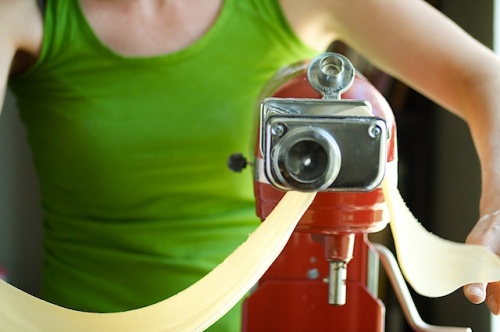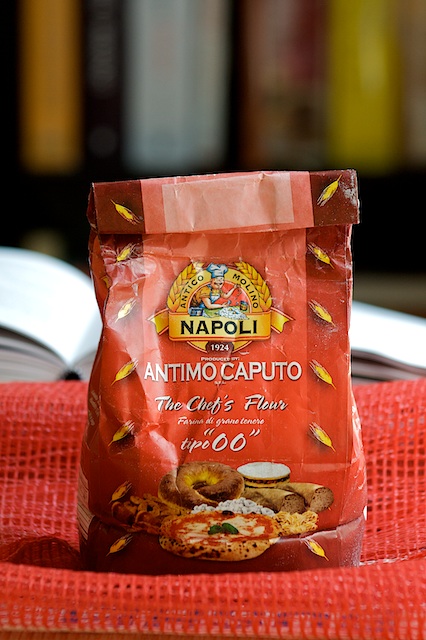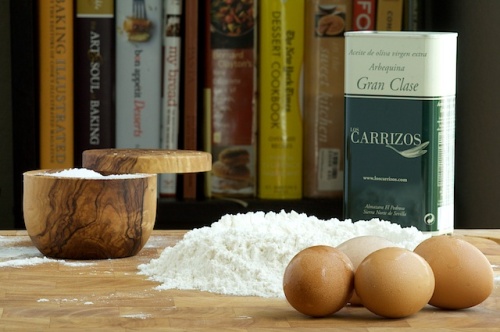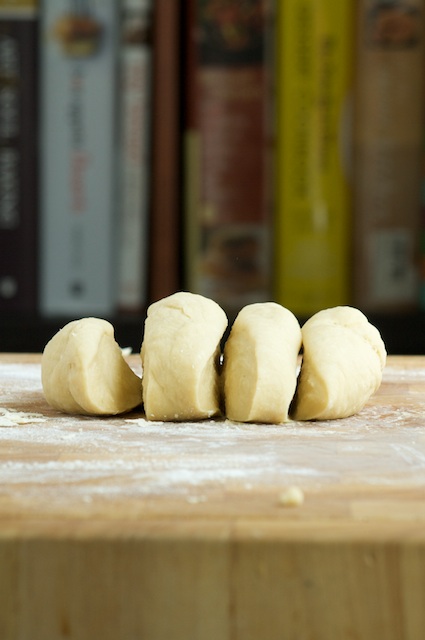The snowball effect exists, even in the month of August. Have you ever set out to do something simple, just for once, and gotten carried away by the fun of it all? For me, it all began with the shelling peas I grew in my garden. Shelling peas inspired an impulse buy of some lonely fava beans at the farmers market (I really don’t need much encouragement to go overboard at the farmers market. How about you?) Favas and peas led to me to think about all manner of related dishes, from falafel to risotto, and eventually, pasta. I decided to make a minted fava and pea ravioli, with a zap of lemon and nutty parmesan cheese. But first, I needed good, fresh pasta. Dried pasta fits the bill on most nights. But I am, after all, still on summer vacation, so I decided to make the most of my remaining leisure time and break out the good old pasta rolling attachment on my mixer.
I needed to brush up on my pasta dough-making skills, so I consulted the Culinary Institute of Spoon With Me, ie: my cookbook shelf. At its core, fresh pasta is made up of flour and eggs, usually including salt, and often, a drizzle of olive oil. I turned to one of my favorite cookbook authors, Sally Schneider. She’s the ‘teach a girl to fish, feed her for a lifetime‘ kind of cookbook author. Schneider imparts her culinary mad skills through pages and pages of basic techniques, and possible improvisations using the techniques taught. Here’s the process, step by step.
First, make a well out of flour on a large surface such as a cutting board, countertop, or large bowl. (I used 00 flour, which some say makes a more tender pasta, but all-purpose flour works here as well). Crack the eggs into the middle, sprinkling the salt and drizzling the olive oil on top of the eggs. Now, I feel that I should give you a heads up about fashioning said flour-egg well. It can spring a leak with barely a moment’s notice, and unleash a gleaming, raging river of egg over the terrain of your counters and floors (speaking from personal experience here). Building a well in a large bowl will both prevent this conundrum, and take away some of the exhilaration that goes along with narrowly avoiding disaster.
Slowly and gradually draw flour in from the interior walls of the well using small circular whisking motions.
And eventually, it will all come together.
Now for one of the most important steps: Kneading. Exact technique is not the key here. Push the dough down, smoosh it, flip and massage it. Don’t stop too soon! Keep going until the dough is smooth, silky, and elastic, with just the slightest bit of stickiness to the touch.
Cut into four equal pieces, wrap in plastic, and let them rest for 30 minutes. While you wait, you can start your sauce or filling.
Now, you can either roll the dough out by hand, or do what I like to do and use a pasta roller. Smoosh (yes, smoosh) one of your pieces of dough into a flat oval. Pass the dough through the roller on the widest setting. Fold the dough into thirds, then feed it through twice more at the same setting (folding each time).
Set your dough roller to the next thinnest setting. Mine starts at “one” for the widest, “seven” for the thinnest. Run the dough through two times (without folding), then turn the knob to the next thinnest setting. Continue the same process, running the dough through twice at each subsequent setting, until you’ve reached the desired thinness. For Ravioli I like my pasta thin, so I made it all the way to the seventh setting. Set your completed dough on a tea towel, cutting in half if necessary. Allow to dry for five minutes, then loosely cover to avoid further drying. From here, you can run your dough through a pasta cutter, cut by hand, or fill to make ravioli.
Learning the technique for making fresh pasta dough opens up an infinite world of possibilities, from customizing your dough with herbs, different flours, or exotic ingredients such as squid ink, to endless combinations of fillings and sauces. Use your favorite sauce, or stay tuned for a ravioli tutorial, a recipe for minted fava and pea filling, and a conglomeration of filling and sauce inspiration from around the web!
What is your favorite way to dress fresh pasta?
- 1¼ cups 00 or all purpose flour, or more as needed
- 4 large eggs
- 1 teaspoon extra virgin olive oil
- ¼ teaspoon kosher salt
- Mound the flour on a large work surface. Create a well in the center with walls about 1½ inches high. Crack the eggs into the well. Sprinkle the kosher salt and olive oil over the eggs. Using a fork, lightly and carefully whisk the eggs, drawing in flour from the inner rim of the well bit by bit until the mixture comes together into a loose, shaggy dough.
- Knead the dough for about 8 minutes until smooth and elastic with just the slightest hint of stickiness, adding a teaspoon of flour at a time as needed to prevent sticking. If the dough feels moist and sticky, knead in a bit more flour.
- Divide the dough into four equal pieces. Form each piece into a ½ inch disc, wrapping each in plastic wrap. Set aside and allow to rest for 30 minutes.
- To roll out the dough, set your pasta machine to the widest setting. Flatten the dough into an oval, and feed the dough through the machine, guiding it with your hands. Fold the dough into thirds, lightly flour it, and pass it through the machine three more times at the same setting, folding each time.
- Without folding, pass the dough through each subsequent setting two times, until the pasta is at your desired thinness. Lay the dough out onto tea towels to dry for five minutes. Repeat with the remaining discs of dough.
- Cut the dough as desired. Here are a few options for pasta cutting.
- To cook, fill a large saucepan with water. Bring to a boil and add a generous amount of kosher salt (the water should taste like the sea). Cook for about 4 minutes, or until tender but still toothsome (Cooking time will change depending on the shape and thickness of the pasta. Add sauce to your heart's desire.













I can see why you were having fun! Very nice!
Love,
Dad!
Grandma Guest
August 5, 2011 1:15 p.m. Carlsbad time!
Jenny, I think we should open a Specialty Gourmet Cooking Shoppe.
It seems there is nothing you can’t create. I envy you. The pasta was interesting. I will appreciate it more now that I know how much work it requires. Love, G.G.
Yum! Can you freeze it or dry it? I have seen fresh pasta at the farmers market that is dried… Do you know how to do that?
Great post. I do ravioli by hand and my wife keeps asking me if I want the attachment for my KitchenAid. Seeing your pictures is tempting me.